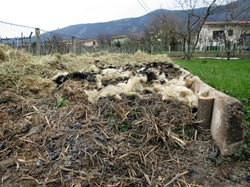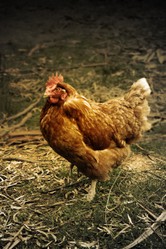Of the many good ideas to come from Germany, one little noticed, but very useful one is hugelkultur, a technique used in Alpine regions of Germany and Austria to enable mountain farmers to make the most of limited space for growing. The word Hugel means mound, and the technique involves making a mound, either a round one or one with a ridge at the top and growing on it. While very useful in mountain regions, it can also be profitably used in desert zones and areas where the soil is waterlogged and therefore so oxygen depleted that it is unsuitable for growing crops.
The basic technique is to dig a trench about 0.3 metres deep and fill it with logs and branches to form the basis of the hugel. This trench can be any length you like, and there is nothing to stop it being long. The logs and branches will over the coming years decay slowly releasing their nutrients for the vegetables. It is better to use wood that is in a state of decay already, for in the initial stages of decay the wood steals nitrogen from the soil at the expense of the vegetables, but in later stages of decay this nitrogen is returned.
Above the trench the soil from the trench is heaped up into a layer, and the grassy turfs laid face down on top of the soil.This is to ensure that the grass does not grow upwards into the vegetable bed, but that it rots down into a source of nutrients. This technique of laying turfs face down is a common one and is used in the making of loam piles and lazy beds. A loam pile is a means of converting turf heaps into soil, and lazy beds used to be common in the West of Ireland and Scotland, and you can find out more about them in my article Growing on the Edge.
Above the upended turfs is laid layer upon layer of organic material: leaves, manure, compost, paper, cardboard and straw. In fact, anything that will rot down is permissible, though there are some woods that you do not want, which I will identify further down.Ideally the materials will be mixed together so as to provide a balanced mix of nitrogenous materials, such as leaves and grass, and carbonaceous materials, such as wood and cardboard. This way you get the best results from the hugel. Planks or logs can be placed along the sides so as to minimize soil slippage.
Hugels decay over time and need replacement, but as they decay they crumble a bit and this allows air to enter the root zone, fostering plant growth. So even the decay is a winning situation.
The books shown below will give you an insight into the world of Sepp Holzer, an expert mountain farmer who has developed hugelkultur greatly.









 Pilgrimage. A review27 days ago
Pilgrimage. A review27 days ago
 Leo the Fourteenthon 05/09/2025
Leo the Fourteenthon 05/09/2025
 The Melsonby Hoardon 03/25/2025
The Melsonby Hoardon 03/25/2025




Comments
They are not as common over here.
Thank you for your comment below in answer to my previous observation and question.
Ticks here attack rainy weather-, tall grass-, wooded area-ambling Unitedstatesians.
Do ticks never, often, rarely burrow into, crawl over similar-activitied British-Isles-ers?
Some ticks. But we are notmplagued with them.
Thank you for your comment below in answer to my previous observation and question.
Mosquitoes and ticks appear to be particularly problematic with all the rainy days last year and this.
Does the British Isles have ticks?
Our problem is less mosquitos, but more midges, which beset visitors to the Scooish highlands in damp weather.
Thank you for your comment below in answer to my previous observation and question.
Storms that cause flooding invariably configure mosquito populations.
Does the mosquito population in the British Isles suddenly appear or expand during or subsequent to floods and storms?
In Permaculture there are no hard and fast rules, so if a mound needs initial covering, cover it.
So you got a storm last night as well. For the first time in my forty one years here in Stretford there was flooding. Fortunately, my house was not affected, as I live near the centre, but minor flooding hit areas near the river.
frankbeswick, Thank you for the practicalities and products. I have the permaculture books but the two Hugelkulture books were unknown to me.
Does one in the beginning cover the mound with plastic or textile to keep the lightweight materials, such as cardboard and leaves, weighted down? There's quite a wind here sometimes. Last night's winds left quite a few branches from the old box elder, black walnut, silver maple and slippery elm here, there, everywhere.
Well observed, but you might place bushes or tall plants on the less sunny side, for they will reach upwards to take the light.
I see how they increase the square footage, but the side away from the sun is not so great for vegetable growing. Is that side vertical? That would indeed enhance garden size.